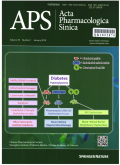- 钛学术文献服务平台 \
- 学术期刊 \
- 医药卫生期刊 \
- 药学期刊 \
- 中国药理学报(英文版)期刊 \
Targeting HMGB1 for the treatment of sepsis and sepsis-induced organ injury
Targeting HMGB1 for the treatment of sepsis and sepsis-induced organ injury
基本信息来源于合作网站,原文需代理用户跳转至来源网站获取
摘要:
High mobility group box 1(HMGB1)is a ubiquitous nuclear protein that is present in almost all cells and regulates the activity of innate immune responses in both intracellular and extracellular settings.Current evidence suggests that HMGB1 plays a pivotal role in human pathological and pathophysiological processes such as the inflammatory response,immune reactions,cell migration,aging,and cell death.Sepsis is a systemic inflammatory response syndrome(SIRS)that occurs in hosts in response to microbial infections with a proven or suspected infectious etiology and is the leading cause of death in intensive care units worldwide,particularly in the aging population.Dysregulated systemic inflammation is a classic characteristic of sepsis,and suppression of HMGB1 may ameliorate inflammation and improve patient outcomes.Here,we focus on the latest breakthroughs regarding the roles of HMGB1 in sepsis and sepsis-related organ injury,the ways by which HMGB1 are released,and the signaling pathways and therapeutics associated with HMGB1.This review highlights recent advances related to HMGB1:the regulation of HMBG1 might be helpful for both basic research and drug development for the treatment of sepsis and sepsis-related organ injury.

推荐文章
高迁移率族蛋白1(HMGB1)的研究进展
HMGB1
先天性免疫
草鱼
斑马鱼
石首鱼
心绞痛与急性心梗患者血清HMGB1的临床意义
冠心痛
心绞痛
急性心肌梗死
HMGB1
高迁移率蛋白1(HMGB1)在宫颈癌中表达及其意义
高迁移率蛋白1
宫颈癌
免疫组织化学
人脑胶质瘤组织中HMGB1?NF-кB的表达及临床意义
胶质瘤组织
高迁移率族蛋白
B1
核因子-kB
内容分析
关键词云
关键词热度
相关文献总数
(/次)
(/年)
文献信息
| 篇名 | Targeting HMGB1 for the treatment of sepsis and sepsis-induced organ injury | ||
| 来源期刊 | 中国药理学报(英文版) | 学科 | |
| 关键词 | |||
| 年,卷(期) | 2022,(3) | 所属期刊栏目 | Review Article |
| 研究方向 | 页码范围 | 520-528 | |
| 页数 | 9页 | 分类号 | |
| 字数 | 语种 | 英文 | |
| DOI | |||
五维指标
引文网络
引文网络
二级参考文献 (0)
共引文献 (0)
参考文献 (0)
节点文献
引证文献 (0)
同被引文献 (0)
二级引证文献 (0)
2022(0)
- 参考文献(0)
- 二级参考文献(0)
- 引证文献(0)
- 二级引证文献(0)
引文网络交叉学科
相关学者/机构
期刊影响力
中国药理学报(英文版)
主办单位:
中国药理学会和中科院上海药物研究所
出版周期:
月刊
ISSN:
1671-4083
CN:
31-1347/R
开本:
大16开
出版地:
上海市太原路294号
邮发代号:
4-295
创刊时间:
1980
语种:
eng
出版文献量(篇)
4416
总下载数(次)
2
总被引数(次)
42236
期刊文献
相关文献
推荐文献
- 期刊分类
- 期刊(年)
- 期刊(期)
- 期刊推荐
中国药理学报(英文版)2022
中国药理学报(英文版)2021
中国药理学报(英文版)2020
中国药理学报(英文版)2019
中国药理学报(英文版)2018
中国药理学报(英文版)2017
中国药理学报(英文版)2016
中国药理学报(英文版)2015
中国药理学报(英文版)2014
中国药理学报(英文版)2013
中国药理学报(英文版)2012
中国药理学报(英文版)2011
中国药理学报(英文版)2010
中国药理学报(英文版)2009
中国药理学报(英文版)2008
中国药理学报(英文版)2007
中国药理学报(英文版)2006
中国药理学报(英文版)2005
中国药理学报(英文版)2004
中国药理学报(英文版)2003
中国药理学报(英文版)2002
中国药理学报(英文版)2001
中国药理学报(英文版)2000
中国药理学报(英文版)1999
中国药理学报(英文版)1998

 免费查重
免费查重










